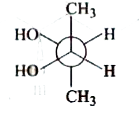When is a molecule said to be chiral?
To determine when a molecule is said to be chiral, we can follow these steps:
1. Definition of Chirality: A molecule is said to be chiral if it cannot be superimposed on its mirror image. This means that the molecule and its mirror image are distinct from one another.
2. Understanding Superimposition: To check for chirality, one can create a mirror image of the molecule. If you can place the original molecule over its mirror image and they do not match perfectly, then the molecule is chiral.
3. Example of Chiral Molecules: Consider a molecule with four different substituents attached to a central carbon atom (like in the case of amino acids). When you create a mirror image of this molecule, the two forms (the original and the mirror image) will not be superimposable.
4. Optical Activity: Chiral molecules are often optically active, meaning they can rotate plane-polarized light. This property is a consequence of their non-superimposable nature.
5. Conclusion: Therefore, a molecule is chiral if it has no plane of symmetry and has non-superimposable mirror images.
Summary:
A molecule is chiral if it has non-superimposable mirror images, typically due to having four different substituents around a central atom, leading to optical activity.
A molecule is chiral if it has non-superimposable mirror images, typically due to having four different substituents around a central atom, leading to optical activity.
Topper's Solved these Questions
- BOOK - ICSECHAPTER - ORGANIC CHEMISTRY : SOME BASIC PRINCIPLES AND TECHNIQUES EXERCISE - SHORT ANSWER TYPE QUESTIONS110videos
ORGANIC CHEMISTRY : SOME BASIC PRINCIPLES AND TECHNIQUES
- BOOK - ICSECHAPTER - ORGANIC CHEMISTRY : SOME BASIC PRINCIPLES AND TECHNIQUES EXERCISE - ESSAY ( LONG ANSWER ) TYPE QUESTIONS42videos
ORGANIC CHEMISTRY : SOME BASIC PRINCIPLES AND TECHNIQUES
- BOOK - ICSECHAPTER - ORGANIC CHEMISTRY : SOME BASIC PRINCIPLES AND TECHNIQUES EXERCISE - REVIEW EXERCISES176videos
ORGANIC CHEMISTRY : SOME BASIC PRINCIPLES AND TECHNIQUES
- BOOK - ICSECHAPTER - HYDROGENEXERCISE - NCERT TEXT-BOOK EXERCISE (With Hints and Solutions)53videos
HYDROGEN
- BOOK - ICSECHAPTER - REDOX REACTIONS (OXIDATION AND REDUCTION)EXERCISE - NCERT TEXT-BOOK. EXERCISES ((With Hints and Solutions)69videos
REDOX REACTIONS (OXIDATION AND REDUCTION)
Similar Questions
Knowledge Check
- Question 1 - Select One or More
Which of the following molecules are chiral?
A B
B C
C D
D
- Question 2 - Select One
Which of the following molecules are chiral ?
 AI, II, III and IVBII, III and IVCII and IVDI and II
AI, II, III and IVBII, III and IVCII and IVDI and II - Question 3 - Select One
Which of the following molecules are chiral ?
 AI and IIIBI and VCII and IIIDII, III, IV
AI and IIIBI and VCII and IIIDII, III, IV
Reactions involving stereoisomers
To study the involvement of stereoisomers in chemical reactions we shall take up following points:
(i)The conversion of an achiral molecule into a chiral molecule, with the generations of a chiral centre.

Secondary butyl chloride exist as two enantiomers but mixture is optically inactive due to formation of a racemic mixture.Both enantiomers are obtained in equal amounts.Racemic mixture is an eqnimolar mixture of two enantiomers.
(ii)Conversion of chiral molecule into chiral and achiral molecules.

Which of the following reactant will give chiral products on monochlorination ?View SolutionReactions involving stereoisomers
To study the involvement of stereoisomers in chemical reactions we shall take up following points:
(i)The conversion of an achiral molecule into a chiral molecule, with the generations of a chiral centre.

Secondary butyl chloride exist as two enantiomers but mixture is optically inactive due to formation of a racemic mixture.Both enantiomers are obtained in equal amounts.Racemic mixture is an eqnimolar mixture of two enantiomers.
(ii)Conversion of chiral molecule into chiral and achiral molecules.

Monochlorination of which of the following will give only an achiral products ?View SolutionWhen is a body said to be in motion ?
View SolutionWhen is a body said to be in uniform motion?
View SolutionWhich of the following molecules is/are chiral ?
 View Solution
View Solution

